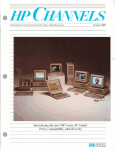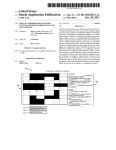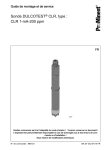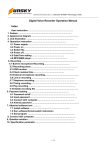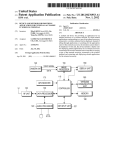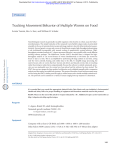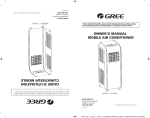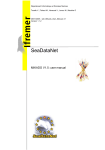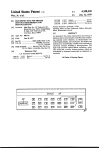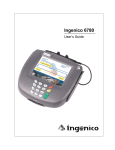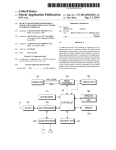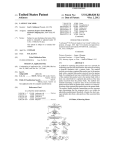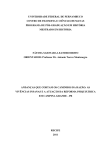Download Secure electronic funds transfer from telephone or unsecured terminal
Transcript
US005371797A United States Patent [19] [11] [4775] Bocinsky, Jr. [54] SECURE ELECI'RONIC FUNDS TRANSFER [57] system that provides substantially equivalent security to Ga. that obtained by the use of secure point of sale terminals such as automatic teller machines, yet is conducted from unsecure terminal devices such as telephones, is disclosed. A customer registers himself or herself per sonally, together with information on his or her bank Bellsouth Corporation, Atlanta, Ga. [21] Appl. No.: 5,350 [22] Filed: [51] [52] [58] ABSTRACT A secure electronics funds or other ?nancial transaction Ronald V. Bocinsky, Jr., Woodstock, [73] Assignee: 5,371,797 Dec. 6, 1994 Attorney, Agent, or Firm—J ones & Askew FROM TELEPHONE OR UNSECURED TERMINAL [75] Inventor: Patent Number: Date of Patent: Jan. 19, 1993 account at a secure transaction processor. A secure Int. 01.5 ............................................. .. H04L 9/32 US. Cl. ................................ .. 380/24; 340/825.34 Field of Search .................................. .. 380/23-25, terminal is used to generate an encrypted version of a 380/ 825.34 encrypted PIN and to the secure transaction processor. [56] personal identi?cation number (PIN) and provides the The encryption key used during encryption of the PIN References Cited is also acquired from either a speci?c request to, or monitoring data passing from a conventional network security transaction processor. The encrypted PIN is parsed with one portion being stored in the customer record at the secure transaction processor and the other U.S. PATENT DOCUMENTS 4,023,013 5/ 1977 4,123,747 10/1978 Kinker ............................ .. 380/24 X Lancto et a1. .. .... .. 380/24X 4,315,101 2/1982 Atalla . . . . . . . . . . . . . . . . . . .. 380/24 X 4,453,074 6/1984 Weinstein . . . . .. 380/24 X being partially masked and provided back to the cus 4,747,050 5/1988 Brachtl et a1. .. .... .. 380/24 X tomer as an access code. Upon conducting a transac . ...... 4,965,568 10/1990 Atalla et a1 ...... .. 380/24 X 5,168,519 12/1992 Scarinci etal . . . .. 380/6 5,283,829 2/1994 ... .. tion, the customer provides the access code, which is unmasked and concatenated with second portion to Anderson ............................ .. 380/24 recreate the original full encrypted PIN. This, together with the encryption key used for the original encryption OTHER PUBLICATIONS is provided to conventional security and transaction Network Interchange Security Systems User’s Manual, processing apparatus for regional banking networks to Feb. 1991, Published by Atalla Network Security Sys seek authorization for the transaction. tems. Primary Examiner-Gilberto Barron, Jr. 9 Claims, 4 Drawing Sheets SECURE POST 0R SWIPE TERMINAL WITH KEYPAD 46 30 SECURE TRANSACTION PROCESSOR K K36 27 (-31 28 PROCESSOR / DISK DRIVE DAii nous X PROC COMMUNI A " REGIONAL NE‘IWORK AUTHORIZATION R 26'\ 47 22 RAM 32 35 0 TO CLIENT NETWORK SECURITY TRANSACTION ORDER PRocEssoR 29 PROCESSOR ( (ATALLA) ; 7 US. Patent Dec. 6, 1994 Sheet 1 of 4 5,371,797 mow h.UFw2-05s320 .l‘I' I.-?gwmWzané mNzoZQiEN?qIS<o J . KNN N F i ,2EI wk z//KN.m‘kmow oE wQmEs5o<az?w9¢%>5¥ N .920w25 .w5moa24mn:y3¢§w2$.H Eémoaiwz NZO_.|<w\m Q,255s / QN| \ )mN/l2mow mo E N h mo(wE8m0l5: Ehzmv.zo US. Patent Dec. 6, 1994 READ STRIPE 5,371,797 Sheet 3 of 4 5.0 DATA as“ STORE N-M CHARACTER PROMPT FOR TELEPHONE SERVICE ACESS NUMBER SEGMENT (SSN) [66 STORE MASK NON NUMERIC CHARACTERS AND CREATE SSTK TSAN AND ACCOUNT INFO PROMPT 67 '\ STORE SSTK /—~55 FOR PIN OBTAIN AUTHORIZATION FROM NETWORK AUTHORIZATION PROCESSOR TRANSMIT M CHARACTER MASKED PORTION TO TERMINAL 56 WRITE CUSTOMER 69 RECORD TO DISK WITH TSAN AS KEY AUTHORIZED YES ERASE DATA & EXIT 70 STORE ENCRYPTION /"* 61 59 KEY PARSE N CHARACTER ENCRYPTED KEY p62 INTO M AND N-M CHARACTER SEGMENTS FIG. 3 US. Patent Dec. 6, 1994 Sheet 4 of 4 5,371,797 PROMPT FOR TSAN PROMPT & 75 85 OBTAIN TRANSACTION INFORMATION 76 PROMPT 77 TERMINATE K TRANSACTION AND REPORT TO CUSTOMER 88 FOR M CHAR. AUTHORIZATIQN OPEN CUSTOMER RECORD WITH PROCESS TRANSACTION LOCALLY REPORT TO CUSTOMER 89 /_“ 78 TSAN KEY 9O UNMASK M CHARACTER 79 AUTHORIZATION CODE USING SSTK FIG. 4 CoNCATENATE M CHARACTER UNMASKED /'“80 CODE AND N-M CHARACTER SEGMENT SEND N CHARACTER ENCRYPTED PIN AND ENCRYPTION KEY TO ATALLA 81 1 5,371,797 2 an ATM transaction at the ATM, irrespective of the identity of the particular bank that owns and operates same. This has provided widespread access to cash from SECURE ELECTRONIC FUNDS TRANSFER FROM TELEPHONE OR UNSECURED TERlHINAL individuals’ bank accounts over a widespread geo TECHNICAL FIELD graphic area. The transaction processing computer operated by the network typically assembles information it receives from the ATM and passes it, normally via dedicated The present invention relates to systems for elec tronic funds transfers or payment authorization that employ personal identi?cation numbers (PIN) and in particular, discloses a systems that can meet the security telephone links, to the host computer at the bank that requirements of banking and credit networks while transmitting transaction information from a telephone maintains the customer’s account. This includes an iden ti?cation of the account, the amount involved and the particular type of transaction requested, and an en set or unsecure point of sale terminal. crypted representation of the personal identi?cation BACKGROUND OF THE INVENTION number input at the ATM. The host computer at the Within the last 20 years there has been an explosive 15 bank then returns data to the network computer indicat ing whether or not the transaction is authorized. If same growth in the United States of America of the use of electronic funds transfers. In particular, there has been is authorized and it is, for example, a cash withdrawal, the account of the customer will be immediately debited at the host computer operated by that customer’s bank. widespread growth of transfer of funds in the form of dispensing cash from automatic teller machines (ATM). ATM systems typically provide each customer with a 20 The network computer passes the authorization up card for operating the machine, which card includes a stream allowing, in the particular example, the ATM to stripe of high magnetic retentivity material on the back dispense cash to the customer. for magnetically encoding data identifying the account Security considerations have led to a number of rela and the customer, and the like. Since such cards are tively stringent requirements imposed by both banks physically capable of being stolen and used by others, most ATM cash distribution systems have adopted the use of a personal identification number, hereinafter also referred to by its common acronym PIN, that must be provided by the customer in order to effect a transac tion using the card. PINs are typically short alphanumeric strings that can be easily remembered by the individual customer. It is critical for the security of the system, or at least for each particular customer’s account, that the PIN not be 25 and the operators of the interbank regional networks. Since we are living in the age of computer hackers and thieves with relatively sophisticated electronic and data processing capability, most of the security requirements have been focused on the main security feature of such ATM networks, i.e., the PIN. Typically, the transaction network requires at least the following constraints on personal identification numbers. In order to prevent interception of a reproducible complete set of data iden tifying a bank transaction, the networks typically re quire that there be no transmission in the clear of a personal identi?cation number. This leads to a require ment that the PIN somehow be encrypted at the termi nal. Additionally, many networks require that all ATM or other point of sale transaction terminals connected to the network encrypt the PIN solely with a hardware written down in any fashion where it is accessible to someone who has stolen the card of the bank customer. As part of the security in a typical ATM transaction system, the PIN is not stored as part of the magnetically coded information on the magnetic stripe of the account card. Therefore, so long as the customer obeys the rule of keeping no written notation of the PIN in the vicinity encryption device in the keypad through which the of the account card, such as in the customer’s wallet or PIN is entered into an ATM. In other words, it is not purse, there is no effective way for the possessor of a acceptable to accumulate the PIN in memory and then stolen card to illegally obtain cash from the ATM. As the use of ATMs has grown and banks seeks to 45 perform an algorithm operating software that encrypts same. This is done principally to prevent any unautho provide enhanced services to their customers, a number rized personnel from gaining access to the PINs via the of ATM authorization networks have been created in telephonic connection thereto and knowledge of the the United States of America. These are normally re gional networks for which multiple banks are members that are arranged in the following manner. Account maintenance computers for each member bank of the network are connected electronically to a transaction computer run by the operator of the network. This operating system driving the ATMs. Thus, many net work operators require a hardware encryption device be interposed between the keypad keys and any micro processor controlling the ATM terminal equipment. Additionally, most networks preclude storage of cus tomer PINs either in the clear or in an encrypted form in transaction processors. Thus, the only location at parts of the customer account records for each member which the actual PIN can be stored is in the customer bank. The customers of each member bank are noti?ed account records of the bank maintaining the account, of the networks of which the bank is a member. Typi which records are on a machine that ultimately pro cally, the individual banks will also place logos or other vides the authorization for any particular transaction. distinctive indicia on their automatic teller machines indicating the particular networks to which its auto 60 While the foregoing discussion of the background of this invention has focused on automatic teller machines, matic teller machines are connected. because of their ubiquitous and familiar nature and their In this way, the customer of any bank that is a mem characteristic of dispensing cash, they are not the only ber of a network can quickly observe any automatic type of device for effecting electronic funds transfer teller machine where the customer happens to be at a time when he or she is in need of cash. If the machine 65 that requires the security of a PIN. Check acceptance systems have used similar arrangements at similar termi indicates that the bank operating same is a member of a nals. Additionally, there is growing use of point of sale particular network of which the customer’s bank is also allows the network to obtain inbound access to certain a member, the customer can insert the card and execute terminals (POST) for directly debiting accounts using 3 5,371,797 4 debit cards or ATM cards. While an immediate debit Assume for the moment that a customer wishes to transaction is disadvantageous to the customer in that register with a mail order retail establishment for imme diate debit or secure credit card transactions. The they lose the ?oat on the credit card billing cycle, it keeps the seller involved in the transaction from having to pay the surcharge typically required by credit card companies and thus, allows them to provide their goods or services at a lower cost. In addition to transactions through secure ATM ma method of creating the necessary record for the secure transaction processor commences with the customer presenting herself at a locale at which a secure point of sale terminal device is available in order to conduct the registration process. Alternately, registration may be chines and the like, signi?cant volumes of business are transacted in the United States via telephonic placement of orders with verbal authorization for payment by a accomplished over unsecure phone lines using DTMF keypads if suf?cient security for the transmission of critical data, including the PIN, can be accomplished. charge to a credit card account. Thus, subject to practical limits on the security of actual Mail order credit card transactions are archetypical transmission of DTMF signals representative of critical unsecure ?nancial transactions. Typically, a customer data such as personal identi?cation numbers, the regis wishing to place an order contacts a seller by telephone. 15 tration steps of the present invention may be accom A credit card number, account name, and expiration plished from an unsecured terminal. date, all of which appear on the face of the credit card, The customer is first prompted to insert her bank are usually provided verbally to an order taker, to account or credit card into the reader of the secure gether with the items ordered and information concern point of sale transaction terminal. Machine readable ing shipment. Most sellers of goods that accept tele 20 account information is read from the magnetic stripe on phonic credit card orders will ship to an address other the card. The customer is then prompted to enter her than the billing address associated with the credit card PIN in a manner thoroughly familiar to users of ATMs. account. This has led to numerous problems including Upon entry of the PIN, it is hardware encrypted with aggregate signi?cant monetary losses to the credit card the secure point of sale terminal’s existing hardware companies, with the purchase of goods using stolen 25 encryption apparatus. This transmits account informa credit cards or purloined credit card information. tion read from the card and an encrypted representation Since secure terminals having hardware encryption of the PIN over data communication lines to the secure devices are relatively expensive, and located in only a transaction processor at which the record of the regis small number of locations, it is highly desirable to pro tration process is to be maintained. Certain parts of the vide apparatus for, and a method of, making electronic 30 account information and the encrypted PIN are passed funds transfers or other ?nancial transactions from un over a regional network system in an altogether con secured terminals that make use of the existing regional ventional fashion to determine the validity of the PIN authorization networks and bank computers and re that has been provided at the secure point of sale termi cords, including the use of personal identification num bers, yet provide a level of security close to or equal to 35 nal, just as it is in conventional ATM transactions. On the assumption that the PIN is valid, the secure that provided by the constraints imposed by typical transaction processor then prompts the customer for regional banking networks in the prior art. entry of a telephone service access number that is SUMMARY OF THE INVENTION uniquely associated with a customer. In most cases this The present invention includes a method and appara 40 will be the customer’s social security number, although tus for addressing the above stated need. Broadly stated, the present invention may be thought of as providing a secure transaction processor that meets the security other numbers uniquely associated with the customer, or at least a particular account, may be employed. Upon completion of this much of the process, the encrypted PIN provided from the secure point of sale connection with the transmission and storage (or actu 45 transaction terminal is parsed into ?rst and second por tions. In preferred forms of the present invention, the ally non-storage) of PINs, yet provides security to the ?rst portion is examined character by character for account holder that prevents fraudulent transactions non-numeric characters that result from the encryption using the account. Broadly stated, it substitutes the algorithm used by the terminal. If non-numeric charac combination of a secure transaction processor upon requirements of typical regional banking networks in which a customer and his or her account have been 50 ters exist in the ?rst portion, they are masked by nu meric characters on a one-to-one relationship with par registered, together with an unsecure point of sale ter ticular non-numeric characters. At the same time, a minal, for preexisting relatively expensive secure point service security translate key (SSTK) is created that has of sale terminals such as automatic teller machines that a particular bit value at each position at which a charac include hardware encryption apparatus. The basic ar rangement of the apparatus of the present invention 55 ter has been masked in the ?rst portion of the encrypted PIN. The masked ?rst portion is then transmitted back includes a secure transaction processor having a record to the customer at the secure point of sale terminal for each customer that includes certain information together with prompting information encouraging the described hereinbelow. The system allows the customer customer to remember this access code. to conduct electronic funds transfer (EFT) or other The preferred method of parsing the encrypted PIN important ?nancial transactions from an unsecured ter 60 minal, such as a swipe reader, with a simple nonen crypted keypad or a telephone set with a dual tone multifrequency (DTMF) keypad. DTMF keypads are into ?rst and second portions is to use a pseudo random number generator to select a random number between 1 and N for an N character encrypted PIN. When this number is selected, the next contiguous M characters ples used in the balance of this speci?cation, either mas 65 (M being less than N) are selected as the portion to the also referred to as touch tone keypads. Through exam culine or feminine gender will be attributed to a particu lar exemplary customer to avoid the recitation of alter native pronouns of each gender. masked and returned to the customer. It should be noted that if the end of the encrypted PIN string is reached, the concept of M contiguous characters, as 5,371,797 7 5 used in this speci?cation, loops around to the beginning of the encrypted PIN. Additionally, the apparatus retrieves from a network 6 ?rst prompted for her telephone service access number which is the record key string for the customer record at the secure transaction processor practicing the pres ent invention. The customer then provides this number via the DTMF keypad on her telephone set. Assuming that a record exists indicating that the cus tomer is registered, the processor then prompts the user for her account access number which is, as noted above, the masked ?rst portion of the encrypted PIN created during the registration process. This numeric data is entered via the keypad and travels over the telephone security transaction processor the current working en cryption key that was used by the secure point of sale terminal to encrypt the customer’s PIN. As is known to those skilled in the art, working keys are the keys em ployed by regional networks and the keys used directly at the secure point of sale terminal such as an ATM machine. The working keys are changed dynamically, for example once a day or several times a day under the control of the network security transaction processors, conventional existing machines that are used in the practice of the preferred form of the present invention. line to the secure transaction processor. The transaction processor then accesses the service is not the only level of encryption that is provided by that are indicated as having been masked to numeric security translate key from the customer’s record and As is known to those skilled in the art, the working key 15 uses same to unmask the particular character positions such machinery. However, the customer record to be data by the SSTK. The resultant unmasked ?rst portion is then concatenated with the stored second portion maintained, for practice of the present invention, needs information from which it can derive the working key from the customer record to recreate the original en that was used to encrypt the customer’s PIN at the time the encrypted PIN was created and parsed, as described above. A customer record is then created at the secure trans crypted PIN. This encrypted PIN, together with the stored encryption key that was originally used to create same, is transmitted, together with other account infor mation and transaction information to a conventional action processor that includes the telephone service network security transaction processor. Note that any access number (social security number in the example) 25 information stored in the customer’s record identifying as the record key. The record also includes the second which particular characters were used for the ?rst por tion of the encrypted PIN provided to the customer is key or data identifying same that was used in the en used at this time to recreate the original (as of registra cryption process by the secure point of sale transaction tion time) encrypted PIN in the proper order. 30 terminal, the service security translate key, an indica The conventional network security transaction pro tion of the random number identifying the starting posi portion of the parsed encrypted PIN, the encryption entire encrypted PIN, and any other desired or needed cessor will need to be programmed or instructed to accept a particular command to receive both the en cord, such as that from the track 2 of the magnetic stripe, in some type of encrypted form for added secu has been de-encrypted using the stored key that is trans mitted to the network security transaction processor, tion of the ?rst portion of the encrypted PIN within the crypted PIN and its encryption key and to use that account data read from the customer’s account card. It particular key to de-encrypt the PIN before commenc may be desirable, although it is not critical to the pres 35 ing conventional transaction processing. Once the PIN ent invention, to store other data in the customer re the PIN is re-encrypted using a current key and a re rity. quest for authorization is transmitted over the regional network. Note that this latter aspect of the process is The customer is now registered at the secure transac tion processor and may conduct sensitive ?nancial transactions in the future via unsecured terminals, which transactions have a very high level of security. In its broadest form, an encryption algorithm may be chosen that does not lead to non-numerical characters entirely conventional since typical existing systems de-encrypt the encrypted PIN provided by an ATM machine and re-encrypt it using a regional key for trans mission over the network. It should be understood that, in summary, the method of the present invention consti tutes both the registration and the use steps described in the encrypted PIN. However, the preferred form is to account for this since encryption algorithms typically above. The apparatus of the present invention consti in use employ a coding scheme in which each four bit tutes the apparatus that is used with and actually per combination represents a hexadecimal digit 0-F. Another aspect of the method of conducting transac 50 forms the steps described. It should be noted from the foregoing description that tions of the present invention is for the customer to this system meets the PIN security requirements of regional banking networks as follows. First, there is no contact the secure transaction processor to, for exam ple, order a particular item through a catalog. Assume storage anywhere in the secure transaction processor or for the moment that same is conducted at the secure transaction processor solely through automated atten dant apparatus that prompts the customer to input cer tain data through a DTMF keypad of a conventional telephone set. The system can be arranged so that or dering information, such as an identi?cation of the 55 any point of sale terminal of any customer’s PIN, either in the clear or in an encrypted form. The only stored information with respect to the PIN is the portion of the customer’s encrypted PIN that is stored at the secured transaction processor. Additionally, there is no trans items, quantity, the size, etc., is provided either before 60 mission of the PIN in the clear as only a masked ?rst portion of the encrypted PIN is transmitted in the clear or after provision of the ?nancial information through the secure transaction processor. However, all of the order information will need to be accumulated prior to requesting authorization from an authorization proces over the telephone lines as the customer’s access code. Therefore, this method and apparatus provides secure electronic funds transfers and other secure ?nancial sor over a regional banking network so that the total 65 transactions from unsecure terminals, including conven tional telephone sets, without compromising the con amount of the transaction can be included in the data that is ultimately provided to the authorization proces ventional security rules of regional banking transaction sor at a bank or credit card operator’s office. The user is networks. 7 5,371,797 It should be noted that the secure transaction proces sor can physically be located almost anywhere desired by the transaction generating entity, including a com puter located on its premises or at a telephone company 8 ware encryption apparatus 12 is embodied as wire con nections between the contacts of the key switches of pad 11 and its output. It is normally apparatus integrally formed with the keypad apparatus. Therefore, it should central of?ce. It is preferable to practice invention using be understood that the representation of a separate ele ment 12 in FIG. 1 is intended principally to illustrate the central of?ce equipment that provides verbal or en function of the hardware encryption apparatus associ coded data prompting to the customer and also main ated with the keypad. Apparatus 15 includes a conven tains the customer records described above. tional microprocessor and associated memory and appa Thus, it should be understood that it is an object of the present invention to provide a method and appara 10 ratus for effecting data communications over data link 16 to a secure transaction processor 17. Data link 16 is tus of conducting electronic funds transfers and other typically embodied by a dedicated telephone line, ?nancial transactions from unsecured point of sale ter leased line, or virtual connection through a commercial minals, including conventional telephone sets that has packet switch network. The structure of processor and transaction security comparable to that provided by data communications apparatus 15 is well known to conventional secure point of sale transaction terminals. those skilled in the art. It includes a UART and some It is a further object of the present invention to pro form of modem for transmitting modulated representa vide secure ?nancial transactions from unsecure point tions of the data signal over data link 16. of sale terminals which, through the use of a secure As noted hereinabove, many of the regional banking transaction processor, generate conventional authoriza tion data, including a personal identi?cation number 20 networks require hardware encryption apparatus, such as that represented by block 12, to be employed in the PIN keypad embodying keypad 11. When the ATM 10 is prompting the user for his or her personal identi?ca regional banking authorization networks. It is still a further object of the present invention to tion number, the encryption apparatus is activated. provide a method and apparatus of registering particu 25 Typically, a PIN is a four digit number. As is known to those skilled in the art, the encryption algorithms of lar customers and particular accounts at secure transac associated with a particular customer and a particular account may be handled over conventional and existing tion processors that may be used to transmit transaction the type employed by hardware encryption apparatus speci?c information to regional banking networks, in 12 are of the type described by the Data Encryption cluding a customer’s PIN, without ever storing the customer’s PIN, either in the clear or in encrypted form. It is still a further object of the present invention to provide a method of and apparatus for conducting ? nancial transactions that have a security level compara ble to that provided by conventional secure point of sale terminal devices such as ATM machines, but still have the convenience of placement of orders and authoriza Standard (DES) promulgated by the National Bureau of Standards. In handling, these number are normally represented as binary coded decimal (BCD) four bit nibbles. Thus, digits 0-9 take values 0000-1001. When the BCD representation of a PIN is encrypted, any bit pattern may result and thus the four bit nibbles may take values between 0000 and 1111. Arithmetically, it is convenient to treat these as hexadecimal digits taking on values 0-F. That the present invention meets these objects and The encryption key that is employed by this encryp tion algorithm is typically 13 characters long, i.e., 52 ful?lls the above described need from the prior art will bits. They are combined as speci?ed in the DES with tions of transactions from an unsecure telephone set. be understood from the description of the preferred the PIN to produce an encrypted form of the PIN that embodiment hereinbelow. is 16 hexadecimal digits long. Algebraic combinations of a key and other bit strings are sometimes used. For example, in some systems an algebraic combination of the customer’s PIN and a bank card number, referred to funds transfer authorization system. as an PAN, may be employed in the encryption process. FIG. 2 is a block diagram of a financial transaction However, same is not necessary and the present inven tion will be described in terms of the direct encryption authorization system of the preferred embodiment. of a PIN. Throughout this speci?cation, the PINs in FIG. 3 is a high level ?ow chart of the process of registering a customer on the system of the preferred 50 their encrypted form are referred to as having a particu embodiment. lar number of characters. In the preferred embodiment, FIG. 4 is a block diagram showing the method of each character is one hexadecimal digit. Furthermore, in the vernacular of this speci?cation, the hexadecimal conducting a transaction. according to the preferred embodiment of the present invention. digits that correspond to decimal digits 0-9 are called 55 numeric characters and hexadecimal digits A-F are DETAILED DESCRIPTION referred to as non-numeric characters. When the personal identi?cation number is entered at Turning now to the drawing ?gures in which like BRIEF DESCRIPTION OF THE DRAWINGS FIG. 1 is a block diagram of a prior an electronics numerals reference like parts and steps, the preferred embodiment of the method and apparatus of the present keypad 11, transaction data representing information invention will now be described. FIG. 1 shows an existing electronic funds transfer ATM 10, together with the 16 character encrypted (EFT) system. A typical representative system is one involving an automatic teller machine (ATM). The about the transaction the customer seeks to perform at PIN, are transmitted over data link 16 to the secure transaction processor 17. Secure transaction processor 17 likewise includes data communication apparatus 18 that communicates with a microprocessor 19 with asso automatic teller machine 10 constitutes a secure point of sale (POS) terminal. It includes a numeric or alphanu 65 ciated memory 20 arranged in the familiar architecture meric PIN keypad 11 that is connected via hardware of an embedded microprocessor controller. The proces sor may be implemented as either an embedded micro encryption apparatus, indicated at 12, to processor and processor machine or a dedicated mini or mainframe data communications apparatus 15. Typically, hard 5,371,797 10 computer for handling transactions from a plurality of etary, the method of encryption is according to the data secure POS terminals such as terminal 10. Processor 19 encryption standard (DES) promulgated by the Na communicates with data communications interface 18 tional Bureau of Standards, as noted hereinabove. Fur via lines 21. The network security transaction processor thermore, the generation and provision of working keys 22 communicates via lines 26 with the data communica to be used by devices such as ATM 10 (FIG. 1 ) is tion interface 18. It thereby communicates with secure performed in accordance with the documented instruc POS terminal 10 via link 16, and with a regional net tions provided by Atalla. In particular, all of the infor work authorization processor 27 via data link 28. mation necessary to successfully use Atalla Network Similarly, processor 19 communicates with network Security Processors is contained in a document entitled security transaction processor 22 via lines 21, the data 0 “Network Interchange Security Systems User’ Man communications interface 18, and lines 26. It should be ual” published by Atalla Network Security Systems and understood that communications with network security transaction, processor 22 typically take place in a multi plexed format in which an instruction is provided fol identi?ed by its part number A34-MN-10150/ 10250. lowed by the data that relates to the particular instruc tion. However, other systems could be used in which nancial networks and is additionally incorporated separate instruction or control lines were provided on a device embodying the network security transaction processor. Security transaction processor 22 includes a memory location represented by block 29 that stores the current encryption key used by the regional network to which authorization processor 27 belongs. Typically, the en cryption keys are changed approximately every two to twenty-four hours and the identity of each new key is transmitted from authorization processor 27 via data links 28 and 26 to the security transaction processor 22 where it is stored at a predetermined location of mem ory indicated as 29. In executing a typical transaction, the following se quence will take place. A customer inserts his bank card into card reader 13 where account information is read and communicated to processor 15. The customer is prompted to enter is PIN in PIN keypad 12. A four digit This document is a well known tool available to those skilled in the art of designing and operating secure ? herein by reference exactly as if set forth in full. Thus, it should be understood that while the identi? cation of the particular keys used in processor-to processor communications are maintained in a con? dential manner, the methodology of the encryption according to the DES and the construction of a ma chine that maintains con?dential keys is known to those skilled in the art. As noted hereinabove, data communication link 16 is typically a dedicated line, leased line, or a link through a commercial packet switched network. However, for locations with a relatively low volume for an ATM such as ATM 10, data link 16 can be embodied by a dial-up line. The security requirements with respect to handling of personal identi?cation numbers described hereinabove in the Background of the Invention section are principally requirements to prevent a party that taps or intercepts communications on either of data links 16 or 28 from ascertaining PINs associated with particular accounts. The requirements also prevent an unautho rized operator from accessing data stored in the mem ory associated with a processor and data communica ing the nature of the transaction that he wishes to make. tions apparatus 15 via data communications link 16 in When complete transaction information is assembled, the transaction data, together with the 16 character 40 order to identify PINs associated with particular ac PIN is hardware encrypted into a 16 character en crypted PIN via hardware encryption apparatus 12. The customer is then prompted for other inputs re?ect encrypted PIN are transmitted over data link 16 to transaction processor 17. The secure transaction proces sor takes care of necessary processing required by the operator of ATM 10. It ascertains whether the transac tion involves an account of the bank that operates trans action processor 17 and ATM 10 or another client bank of a regional network with which such operator is af?li ated. If it is the latter, the processor maintains a record of the transaction and notes that it has dispensed cash counts. _ FIG. 1 describes the existing prior art systems for authorizing EFT transactions, both locally with secure transaction processor 17 and using regional banking networks. As noted hereinabove, it is a principal pur pose of the present invention to provide both a method and apparatus for conducting transactions of equal sen sitivity from unsecure terminals, rather than requiring a secure point of sale terminal such as terminal 10. These from its ATM machine to the customer of another bank 50 transactions are conducted in a manner that has both a very high level of security and satis?es certain security based on the presentation to ATM 10 of a bank card from another banking institution. If the transaction is, for example, withdrawal of cash requirements of regional banking networks with respect work authorization processor 27 over data link 28. Net work security transaction processor 22 is typically em cessor 22 is also included in the secure transaction pro cessor 30 of the preferred embodiment. It should be bodied in Atalla Network Security Processor as cur noted that conceptually, the network security transac rently manufactured by Atalla Corporation. Atalla Cor tion processor may be considered as included within, or external to, the secure transaction processor when ana to the handling of PIN data. Turning next to FIG. 2, a block diagram of apparatus from an account in another bank, the 16 character en crypted PIN and the encryption key that were provided 55 embodying the present invention is shown. It includes a secure transaction processor 30 of similar general archi over data link 16 are passed to the network security tecture to prior art transaction processor 17 which, transaction processor 22. This device de-encrypts the however, functions differently in several important PIN, and then re-encrypts same using the current key respects. An Atalla network security transaction pro stored in memory 29 for transmission to a regional net poration is well known to those skilled in the art of secure ?nancial transactions and is an affiliate of Tan 65 lyzing the present invention at a system level. It is im dem Computer Company. While particular encryption keys used between portant that the function performed by the network security transaction processor apparatus be performed, Atalla Network Security Processors remain propri but it is not critical whether same is considered to be a 11 5,371,797 part of the security transaction processor or an external processor. Secure transaction processor 30 includes a micro processor or other CPU apparatus 31 with associated external random access memory (RAM) 32 and read only memory (ROM) 35 connected thereto. Addition ally, magnetic memory is provided by a disk drive shown as 36 for storing customer registration records as described in greater detail hereinbelow. Of course, 12 1 which can communicate over data link 45 with trans action processor 30, and which will only transmit en crypted forms of a customer’s PIN. As noted brie?y hereinabove, secure transaction pro cessor 30 may be one of a plurality of processors located at various locations, or a central computer operated by the client of the regional network. In this speci?cation, the client of the system is the entity that will be receiv ing the electronics funds transfer authorized by its cus other storage media may be employed in embodiments 10 tomer. Thus, the customer is the party that owns the bank account and the client is the party to whom the of the present invention but relatively large hard disk customer wishes to transfer funds. Alternately, the se drives are currently preferred. Transaction processor 30 includes a data communica tions interface 18' that communicates via data link 26’ with the network security transaction processor 22 in a manner identical to that of the prior art illustrated in FIG. 1. The preferred embodiment includes speech synthesizing apparatus. Typically, the data communica cure transaction processor may be embodied by any form of specialized computer that is connected to or forms a part of central of?ce switching equipment by a telephone company. One example of same are service circuit nodes that connect directly to electronic switch ing equipment for a central of?ce such as those manu factured and sold by American Telephone & Telegraph tions interface 18' will be a multiport device that can handle a plurality of transactions at any given time. 20 Company. ' Another data link 47 is shown as coming from data Two representative input ports are shown as 37 and 38 communications interface 18 and going to a client order in FIG. 2. processor. This link is typically an asynchronous serial Port 37 is connected to a DTMF decoder 39 that is, link or a connection via local area network. Alternately, in turn, connected to a subscriber line 40 that forms part of the public switched telephone network (PSTN). In 25 an asynchronous link may be connected to a modem for transmission of order information to a computer at a FIG. 2, subscriber line 40 is shown as connected to a remote site. Of course, the computer that constitutes typical telephone set 41 having a DTMF keypad 42 by secure transaction processor 30 may also perform the which the user can transmit numeric information to function of a client order processor. A client order transaction processor 30. As will be apparent to those skilled in the art, the function DTMF decoder 39 may 30 processor is contemplated when, for example, the sys also be implemented by an external DTMF decoder that passes decoded data to secure transaction processor 30 or by apparatus which allows processor 31 to di tem is being used by a mail order retail operation. Disk drive 36 holds customer records for registered custom ers and also maintains information on customer transac tions. Having described the physical structure of the pre Port 38 is connected to a modern within data commu~ 35 ferred embodiment shown in FIG. 2, the methods of nications interface 18’. Its input is data link 45 that may registration and execution of a transaction in accor be embodied by a connection via the public switched dance with the preferred embodiment of the present telephone network, commercial packet switched net invention will now be described in connection with work connection, or dedicated phone lines. Data link 45 is connected to terminal equipment that, 40 FIGS. 3 and 4. Reference will also be made to FIG. 2 during this discussion in order to indicate the particular in the preferred embodiment, is embodied by a swipe apparatus that performs certain steps of the method in terminal with a keypad 46 of the type known to those rectly decode inbound DTMF signals. skilled in the art or a secure terminal similar to ATM 10 the preferred embodiment. FIGS. 3 and 4 are high level flow charts of the logic (FIG. 1). A swipe terminal has a swipe reader for read ing the information stored on the magnetic stripe of a 45 that controls processor 31 within secure transaction processor 30. The writing of computer code to imple bank card and a keypad by which numeric data may be ment these steps, for a given type of processor and entered by an operator. operating system, will be apparent to those skilled in the The examples of telephone set 41 and terminal 46 are art. Selection of a processor and a language in which to not intended to be limiting of the type of terminal equip ment that may be used in a system embodying the pres 50 write such instructions, are matters of design choice. ent invention. Indeed, data terminal equipment includ ing computer devices, dumb terminals, and other appa Preferably, coded instructions for performing the methods shown in FIGS. 3 and 4 are burned into read only memory 35 and such instructions are fetched by ratus are contemplated as devices that can communicate processor 31 in a well known conventional manner. with the secure transaction processor 30 of the present invention. In the preferred embodiment, terminal 46 is 55 Alternately, such instructions may be stored on disk drive 36 and loaded into random access memory 32 for one of the types of devices used for customer registra execution. tion on the system and execution of ?nancial transac FIG. 3 shows the method of registration used in the tions by a registered customer. In the preferred embodiment of the present invention, preferred embodiment. This is preferably accomplished registration will take place at a terminal 46 with data with a secure point of sale terminal, such as ATM termi link 45 representing a direct connection to the secure nal 10, embodying terminal 46 and being connected to transaction processor 30. Thus, the terminal and the processor would be on site at the location where regis tration was taking place. This is to prevent transmission communication link 45 shown in FIG. 2. After appro priate prompting to the customer and the customer’s selection of a registration function, the magnetic stripe over telephone links, which is susceptible to intercep 65 data is read by the point of sale terminal at step 50. At tion, of a customer’s PIN. step 51, processor 31 causes a message to be sent over Alternately, registration takes place using a secure point of sale terminal such as terminal 10 shown in FIG. data link 45 prompting the user for a unique identifier that will serve as a telephone service access number 13 5,371,797 14 (TSAN) in conducting future transactions. The method tion processor 22 to identify the working key currently of the preferred embodiment uses the TSAN as the record key in the customer records stored on disk drive 36. Therefore, it is important to have the user select a number that is uniquely associated with her. The most apparent choice is an individual’s social security num ber and that is what is used in the preferred embodi in use by each particular remote terminal (or all remote terminals connected to the processor). The necessary point to be understood is that processor 31 must have some indication of the key that was actually used in the process of encrypting the PIN while creating the cus tomer’s record described herein. ment, although other numbers or strings of alphanu Thus, to this point, data identifying the customer’s meric characters may be employed in embodiments of bank account, the customer’s telephone service access the present invention. l0 number (normally social security number) and the en On the assumption that the user enters same, data cryption key used to encrypt the 16 character en representing the telephone service access number is crypted PIN originally transmitted by the terminal are acquired and stored at step 52, together with account in the system. The routines at step 62 create the ?eld information that was read from the magnetic stripe of entries for the registration record that provide the very 15 high level of security while still providing a service that the bank card at step 50. At step 55, the customer is prompted for entry of her can use the existing network security transaction pro cessors and the PINs associated with particular bank PIN. In the example described, the PIN will be en accounts at the account records maintained by the crypted via hardware encryption apparatus 12 (FIG. 1) and the 16 character encrypted PIN is transmitted to bank’s computer. At step 62, the 16 character encrypted PIN is parsed secure processor 30 (FIG. 2) in a conventional fashion. It should be noted that the preferred embodiment of the into a ?rst segment of seven characters and a second registration process illustrated in FIG. 3 is one in which segment of nine characters. In the drawing, step 62 references an N character encrypted key and parsing secure transaction processor 30 (FIG. 2) generates prompts to the user during the registration process. It same into M and N-M character segments. To practice will be apparent to those skilled in the art that the 25 the present invention, it is clear that N must be a posi prompting steps can be performed either locally under a tive integer greater than one, although a two character encrypted PIN would provide a relatively low level of local prompting control program, at terminal 46 (FIG. security. M must also be a positive integer and it must be 2) with all accumulated data being sent in one group or a packet after the customer has been prompted for all less than N. From this description, it will be apparent necessary entries. that, in the preferred embodiment, N= 16 and M =7. Of Step 56 represents a routine for obtaining authoriza course, other combinations of N and M may be used in methods that practice the present invention. tion from a network authorization processor. This rou tine includes the steps of passing the 16 character en As noted hereinabove, the preferred mode of parsing crypted PIN to the network security transaction pro the 16 character encrypted PIN is to use processor 31 to cessor 22. There it is de-encrypted and re-encrypted 35 generate a pseudo random number R, which number using the current key of the regional network stored in de?nes a beginning point for the M character ?rst por tion of the PIN to be provided back to the customer. memory location 29. The re-encrypted PIN together The number R is a positive integer having values in the with other transaction speci?c information is then passed over data link 26’ to processor 31. Processor 31 range [1,N]. The next contiguous M characters, begin in turn transmits the information on to regional network 40 ning with the Rth are chosen to be the M character ?rst portion. Note that if there are less than R characters to authorization processor 27, which information includes the re-encrypted PIN, to con?rm the correspondence between the particular account identi?ed from the mag netic stripe data at step 50 and the PIN entered by the customer in response to step 55. the right of the starting position in the 16 character encrypted PIN, the selection of the M characters wraps around to the beginning. The remaining parts of the 45 original 16 character encrypted PIN are then concate entered at the terminal. If the result of this test is nega nated to form the N—-M character second portion that is stored in the customer record on this disk drive 36. Thus, it will be apparent that if R is less than or equal to (N -M+1) then all M characters may be selected from a contiguous portion of the original N character tive, NO branch 58 is taken and the data acquired here tofore is erased and the routine is exited at step 59. If the encrypted PIN without wrapping around. If this rela tionship is not satis?ed, the last (N—R+ 1) characters At step 57, processor 31 tests the data that is returned by the regional network authorization processor 27 over data link 28 to see if the transaction is authorized, i.e., whether the PIN for the account has been correctly (beginning at the Rth position) are selected as the ?rst network authorization processor 27 reports an affirma characters and these are followed by the ?rst tive result for the PIN, YES branch 60 is taken to step 55 (M—N+R— 1) characters from the beginning of the N 61. At step 61', the encryption key provided by the net work security transaction processor 22 is stored. It should be noted that the encryption key used during the encryption of the customer’s PIN by terminal 46 when the PIN is ?rst entered during the registration process is provided to processor 31 by network security transac tion processor 22. In the preferred embodiment of the present invention, secure transaction processor 30 mon character encrypted PIN. The reassembly of the original N character encrypted PIN from knowledge of the values of N, M, and R, will be apparent to those skilled in the art. The use of the random number to select this circular parsing point for selecting the ?rst M characters of the N character en crypted PIN adds additional security to the system. At step '65, the nine character second segment of the itors the provision of new working keys to terminals encrypted PIN is stored in the buffer in which the cus such as terminal 46 and thus, has information about the 65 tomer record is being assembled. It should be noted that this constitutes part, but not all, of the encrypted PIN. particular key that is used to encrypt the customer’s PIN while registration is taking place. Alternately, Thus, this segment, together with the encryption key, commands can be issued to network security transac cannot be used to derive any meaningful information 15 5,371,797 16 minal together with instructions to the customer to make note of same and preferably to memorize it for use about the actual PIN that gave rise to the encrypted PIN. As is well known to those skilled in the art, the encryption algorithms of the type employed are such as an access number when conducting transactions on that the entire PIN, as well as the entire encryption key, potentially impact each hexadecimal character. Thus, it the system. It may be desirable to implement step 68 by encrypting the M character ?rst portion prior to trans is not possible to recover part of the PIN from a knowl mission over data link 45 to terminal 46. If this is em edge of an incomplete version of the encrypted PIN and segment that is employed by the preferred embodiment ployed, terminal 46 will need to be equipped to de encrypt the N character portion so that it may be dis played in the clear to the customer. Either speci?c encryption accomplished by processor 31, or the ser takes place. There are two desirable effects from this. vice of encryption provided by network security trans the encryption key. At step 66, the masking of the ?rst seven character action processor 22 may be used in such an implementa tion of this step. least in a signi?cant fraction of cases) a service access The routine at step 69 writes the customer record to number that is not part of the actual 16 character en crypted PIN. Secondly, it is believed preferable for 15 disk 36 with the telephone service access number (social security number) as the record key string that is used by customers to have only numerical characters to remem the index of the data base storing customer records as ber as part of an access number for using the system of First, it provides increased security in providing (at the key to locate this particular customer’s record of registration. When this is completed, the routine is ex of this speci?cation are hexadecimal digits. Thus, in 20 ited at 70 and the customer’s registration is complete. It should be noted that while it is preferred to mask order to provide a decimal digit character for each the non-numeric characters of the M character (7 in the character position, hexadecimal digits having values preferred embodiment) ?rst segment as shown at steps A-F must be masked. The preferred embodiment masks 66 and 67, this is not necessary in order to practice the these characters according to the following table. 25 present invention in its broadest form. The main secu rity advantages from parsing an encrypted PIN and B the preferred embodiment. As noted hereinabove, characters used in the context minal» passing a ?rst segment of it back to the customer and C D En F=7 storing a second segment of same are available in a 30 system that omits the masking and unmasking steps. Furthermore, it should be understood that it is impor Of course, other masking relations may be used. If the tant to use a secure point of sale terminal in order to security feature of the masking is considered desirable, accomplish the registration process without having that the table used may be changed according to other crite ria, such as date of registration, in order to make deci pherment of the encrypted PIN even more difficult for process itself becoming a potential breach of the secu rity of the system. However, in addition to conventional secure point of sale terminals such as ATMs and other a person having unauthorized access to the customer devices employing hardware encryption, a swipe termi nal that employs adequate encryption or a terminal that is connected only locally (i.e., without any intervening records. It should be noted that the above referenced table is one that simply complements the most signi?cant bit of transmission through the telephone network) also quali the hexadecimal digits for values greater than nine. 40 ties as a secure terminal for the method of registration of the present invention. Therefore, the masking can be easily processed by Turning next to FIG. 4, the process of conducting a changing the most significant bit from 1 to O for hexa transaction by a registered customer is illustrated in a decimal digits A-F which is arithmetically the equiva high level flow chart. Again, this chart represents the lent of subtracting 8. In the routine represented at 66, a record of the par 45 sequential steps executed by processor 31 of secure transaction processor 30. In this example, it is assumed ticular characters that are masked is generated and that the customer who became registered in FIG. 3 maintained in a service security translate key (SSTK). wishes to place an order for a particular item over her This is preferably a single eight bit byte, seven bits of which are used to record, on a bit-by-bit basis, the posi telephone and to debit her bank account at the time the tions of the seven character access number that were order is placed. Thus, in the example described, the masked. A l is inserted at each bit position for which masking takes place and a O is inserted at character ?nancial transaction will be originated and controlled via the use of telephone set 41 with its DTMF keypad positions for which there is no masking. For example, if the seven character ?rst segment of the encrypted PIN was 12A34F5, the system would mask the A and the F 42 shown in FIG. 2. It should be understood that this is not limiting of the type of unsecure terminal (or a secure terminal) that can be used to execute a ?nancial transac characters. The resulting masked ?rst segment would tion for a registered customer. Thus, text transmitted become 1223475. Since characters at the third and sev via modems can be used on terminals and computers or other devices may be available, limited only by the enth positions (from left to right) were masked, the types of appropriate interfaces that are implemented seven signi?cant bits of the service security translate key that results from this operation would be 0010010. 60 and supported by secure transaction processor 30. In the present example, it should be understood that Thus, the service security translate key is available, as will be described in connection with FIG. 4, to reverse the process of masking in order to reassemble the en crypted PIN originally generated during the registra tion process. DTMF decoder 39 is operative to detect the presence of DTMF signals on line 40 and to pass on digital indica tions of same, when present to port 37. Also, port 37 65 includes an audio link between data communications At step 67, the service security translate key is stored interface 18' and subscriber line 40. In this example, data in the buffer. At step 68, the masked seven character portion of the encrypted PIN is transmitted to the ter ulary speech synthesizer for generating audio prompts communications interface 37a includes a limited vocab 17 5,371,797 to subscriber line 40 that are audible at standard tele phone set 41. The technology for such speech synthesis is well known to those skilled in the art and need not be described in detail. With that background, assume that the user has taken telephone set 41 off hook and dialed an appropriate number to become connected to secure transaction processor 30 in order to conduct a ?nancial transaction over the telephone. Assume she wishes to place an order for a particular item and have her bank account debited for same. At step 75, processor 31 and data communications interface 18' interact to cause the inter face’s speech synthesizer to audibly prompt the user to enter her telephone service access number. Assuming 18 should be understood that one of the signi?cant advan tages of the present invention is that secure transaction processor 30 and the unsecured terminal in the form of telephone set 41 act together to provide a secured sys tem that mimics a secure point of sale terminal such as ATM 10 shown in FIG. 1. It accomplishes this mimicry and interacts with network security processor 22 and regional network authorization processor 27 in a man ner that does not require either of these devices to pro vide any special response because of the source of the transaction data and request for service, except as noted above. Returning to the example of the transaction, proces control moves to step 76 at which audible prompts are sor 31 reads data coming back over data link 28, in a conventional fashion to determine if the transaction was authorized. This takes place at step 82 shown on FIG. 4. provided for entering transaction information. For ex If the customer’s bank reports that the transaction is not same is entered properly at keypad 42, this is stored, and authorized, NO branch 85 is taken to step 86, which ample, a request may be made for the user to enter an terminates the transaction and reports the lack of autho item number, followed by a request that a number be entered indicative of the number of units to be pur 20 rization verbally to the customer. chased, followed by codes for size, color, etc., for items to which such parameters apply. These are stored by processor 31 in RAM 32 in response to signals identify Assuming the happier result of an authorized transac tion, YES branch 87 is taken to step 88 at which the transaction is processed locally. This represents either processing of the order within secure transaction pro When this is completed, the user is verbally prompted 25 cessor 30 or communicating the nature of the order out ing decoded touch tones from DTMF decoder 39. to enter her seven character access code. When this over data link 47 to a client order processor. In either instance, the debit transaction has been authorized and recognized by the customer’s bank, and it is now simply a question of the mechanics of processing the custom step 78 and is ready to complete processing of the order. The service security translate key (SSTK) is retrieved 30 er’s order to deliver the goods she desires. When the access code is obtained, the processor opens the cus tomer record with the TSAN as the identifying key at from the customer record on disk drive 36 and is used to unmask the masked characters by reversing the masking process described hereinabove in connection with the registration process of FIG. 3. This step is illustrated by order is processed the customer is debited and an elec tronic transfer of funds into the client’s (seller) account is made. It should be noted that order processing steps, such as 35 checking the availability of items in inventory and the routine 79 in FIG. 4. like, can be performed during step 76 at which transac When this is completed, the secure transaction pro tion information is obtained, giving the customer an cessor has the unmasked seven character (M character) opportunity to terminate the ordering process if particu ?rst portion of the original 16 (N) character encrypted PIN and the nine character (N ——M) second portion that lar items are not available or will require an unaccept is stored in the customer record in disk drive 36. These are concatenated at step 80 to recreate the original en ably long time for delivery. Once local transaction pro cessing has been completed, a verbal report is provided crypted PIN that was used during the registration pro cess. Routine 81 sends the 16 character encrypted PIN to the customer at routine 89. This is again done by and the original encryption key, also obtained from the data communications interface 18’ to generate the ap having processor 31 drive the speech synthesizer within customer record, to the network security transaction 45 propriate verbiage on subscriber line 40. Following this, the routine is exited at point 90, as the transaction has processor 22 via data link 26'. Note that the routine been completed. illustrated at 81 transmits data to the processor 22 that, While the foregoing embodiment represents the best for purposes of processor 22, is completely transparent mode contemplated by the inventor at the present time, to the fact that it was created by taking the masked there are other embellishments which could add addi seven character segment entered at keypad 42, unmask tional security that are also being contemplated. It is ing same and combining it with the nine character seg unclear as of the time of the writing of this speci?cation ment stored on disk drive 36. The Atalla processor 22 whether the additional security provided would tend to need only be provided with the encrypted PIN and the be cost effective. However, one example currently con encryption key used during such encryption and it will respond to this as it would any other request for service. 55 templated by the inventor is the employment of voice print identi?cation as an additional parameter for autho Therefore, when executing the routine illustrated at rizing a transaction. In such an embodiment, voice 81, the Atalla processor de-encrypts the customer PIN printing information would be acquired during the re and re-encrypts same using the then current encryption gistration process and stored as part of the customer’s key that is stored in the memory location 29 from the record on disk drive 36. This would require analysis of regional network it services. The re-encrypted PIN, a voice signal, which the customer would be prompted together with account and transaction information is then provided by the network security transaction pro to speak during a purchase transaction, by voice print cessor 22, in a conventional manner, out over data link 28 to processor 31. Processor 31 in turn sends the re possible to employ such voice print identi?cation only analysis routines running on processor 31. It is also quest out over data links 21’ and 28 to the regional 65 in connection with transactions coming in over certain classes of telephone lines and to also allow placement of network authorization processor, which in turn com orders via modem over other classes, for example, calls municates with the customer’s bank to process the passing through commercial packet switch networks. transaction in a conventional fashion. Therefore, it 19 5,371,797 ~ Additionally, it may be desirable to periodically reen crypt and re-parse the customer’s PIN and require the customer to call in and provide her TSAN to obtain the 20 ?rst memory means for storing an account record including said record key string associated with said particular account, an N-M character sec New M character portion. From the foregoing, it will be appreciated that the 5 ond portion of said encrypted PIN, a service security translate key identifying each of said M method and apparatus of the present invention meet the above stated objects of the invention and ful?ll the need in the prior art described hereinabove. In view of the ter, and said encryption key; characters that is a masked non-numeric charac processor means connected to said memory means and to said data communications link for: detailed description of the preferred embodiment con tained herein, other embodiments of both the method and apparatus of the present invention will suggest accessing said account record in response to re ceipt of said record key string, themselves to those skilled in the art and therefore the scope of the present invention is to be limited only by the claims below and equivalents thereof. 15 What is claimed is: combining said masked M character ?rst portion of said N character encrypted PIN and said service security translate key to provide an unmasked M character first portion of said N character en character encrypted PIN, N being a positive integer crypted PIN, and combining said unmasked M character ?rst portion and said N-—M character second portion of said encrypted PIN to reproduce said N character associated with a particular account and a particular means for providing said N character encrypted PIN and said encryption key to said network 1. In a system for processing a ?nancial transaction from a particular customer of the type requiring provi sion to a network security transaction processor of an N greater than one, and an encryption key, wherein said N 20 character encrypted PIN is a representation of a PIN security transaction processor. customer that was encrypted using said encryption key, the improvement comprising: means for establishing a data communications link between an unsecured point of sale terminal device and a secure transaction processor wherein said encrypted PIN; and 3. A method of processing a ?nancial transaction 25 point of sale terminal device is operable to provide data representing an M character ?rst portion of 30 said N character encrypted PIN, M being a posi tive integer less than N, and a record key string associated with said particular customer; said secure transaction processor including; ?rst memory means for storing an account record 35 including said record key string associated with said particular account, an N-M character sec ond portion of said encrypted PIN, and said encryption key in a record; processor means connected to said memory means and to said data communications link for: accessing said account record in response to receipt of said record key string, and combining said M character ?rst portion and said N-M character second portion of said en crypted PIN to reproduce said N character encrypted PIN; and means for providing said N character encrypted PIN and said encryption key to said network security transaction processor. 50 2. In a system for processing a ?nancial transaction from a particular customer of the type requiring provi sion of a PIN associated with a particular account and said particular customer to an authorization processor comprising the steps of: (a) registering said account at a secure transaction processor by; (i) encrypting said PIN with a predetermined key to provide an N character encrypted PIN, N being a positive integer greater than one; (ii) providing an M character ?rst portion of said encrypted PIN to said particular customer, M being a positive integer less than N; (iii) obtaining a record key string uniquely associ ated with said account; (iv) storing said record key string and an N-M character second portion of said encrypted PIN in a record at said secure transaction processor; (v) storing an indicia associated with said predeter mined key at said secure transaction processor; (b) contacting said secure transaction processor via an unsecured data link and providing said M char acter ?rst portion of said encrypted PIN and said record key string over said data link; (0) combining said M character ?rst portion and said N-M character second portion of said encrypted PIN to reproduce said N character encrypted PIN at said secure transaction processor; from a particular customer of the type requiring provi (d) obtaining said predetermined key and using same sion to a network security transaction processor of an N to de-encrypt said N character encrypted PIN to provide a reproduced PIN; and (e) causing said secure transaction processor to estab character encrypted PIN, N being a positive integer greater than one, and an encryption key, wherein said N 55 character encrypted PIN is a representation of a PIN associated with a particular account and a particular customer that was encrypted using said encryption key, the improvement comprising: means for establishing a data communications link between an unsecured point of sale terminal device lish communication with said authorization proces sor, and to encrypt said reproduced PIN using a current authorization network key, to provide a re-encrypted PIN and other data associated with said particular account to said authorization pro cessor. and a secure transaction processor wherein said 4. A method of processing a ?nancial transaction point of sale terminal device is operable to provide from a particular customer as recited in claim 3 wherein data representing a masked M character ?rst por said step (a)(ii) includes the steps of: . tion of said N character encrypted PIN, M being a 65 identifying each of said M characters that is a non positive integer less than N, and a record key string associated with said particular customer; said secure transaction processor including; numeric character, masking each said non-numeric character with an associated predetermined numeric character to 5,371,797 21 provide a masked M character ?rst portion of said encrypted PIN, and creating a service secu 22 particular account to said authorization processor over said second data communications link. rity translate key identifying the particular ones 8. A method of creating a secure record at a secure of said M characters of said masked M character transaction processor which record is used for process ing ?nancial transactions from a particular customer having a machine readable account card associated with ?rst portion of said encrypted PIN that have been masked; and said step (a)(iv) includes a step of storing said service security translate key in said record at said secure transaction processor. 5. A method of processing a ?nancial transaction from a particular customer as recited in claim 4 1 O wherein: ‘ a said step (0) includes a step of accessing said service security translate key and using same to unmask said particular ones of said M characters of said masked M character ?rst portion of said encrypted PIN that have been masked. 6. A method of processing a ?nancial transaction from a particular customer as recited in claim 3 wherein said step (a)(ii) includes the steps of: providing a random integer number R with a value 20 in the range; selecting said M character ?rst portion of said en crypted PIN as the ?rst M characters of said encrypted PIN beginning with the Rth character thereof; and said step (a)(iv) includes a step of storing said integer number R in said record at said secure transaction processor. 7. A ?nancial transaction processing system for pro cessing of the type requiring provision of a PIN associ ated with a particular account and a particular customer to an authorization processor comprising in combina tion: ' means for establishing a ?rst data communications link between an unsecured point of sale terminal device and a secure transaction processor wherein 35 said point of sale terminal device is operable to provide data representing an M character ?rst por tion of N character encrypted PIN, M being a positive integer less than N, and a record key string associated with said particular customer, said N character encrypted PIN being encrypted using a predetermined encryption key; a secure transaction processor including; ?rst memory means for storing an account record including said record key string associated with said particular account, an N-M character sec 45 ond portion of said encrypted PIN in a record, and said predetermined encryption key; processor means connected to said memory means and to said ?rst data communications link for: accessing said account record in response to 50 receipt of said record key string, combining said M character ?rst portion and said N-M character second portion of said en crypted PIN to reproduce said N. character encrypted PIN, using said predetermined encryption key to de encrypt said N character encrypted PIN to pro vide a reproduced PIN; and network communication means for establishing a second data communications link between said secure transaction processor and said authorization 60 processor; second memory means for storing a current authori zation network key provided by said authorization processor; and means for re-encrypting said reproduced PIN using 65 said current authorization network key to provide a re-encrypted PIN and for providing said re encrypted PIN and other data associated with said at least one particular account of said particular cus- , tomer, and which account and customer have a PIN associated therewith comprising the steps of: providing a secure point of sale transaction terminal with secured PIN pad encryption apparatus and card reading apparatus; causing said secure point of sale transaction terminal to prompt said customer to insert said machine readable account card and reading account infor mation stored on said account card; causing said secure point of sale transaction terminal to prompt said customer to enter said customer’s PIN and, in response to entry thereof, using said secured PIN pad encryption apparatus and a prede termined encryption key to provide an N character encrypted PIN, N being a positive integer greater than one; causing said secure point of sale transaction terminal to prompt said customer to enter a telephone ser vice access number uniquely associated with said customer; transmitting said telephone service access number, said account information and said N,character en crypted PIN to said secure transaction processor; establishing communication with an authorization processor and verifying that said PIN is associated with said particular account; parsing said N character encrypted PIN to provide an M character ?rst portion of said encrypted PIN, M being a positive integer less than N, and an N-—M character second portion of said encrypted PIN; identifying each of said M characters of said M char acter ?rst portion of said encrypted PIN that'is a non-numeric character and masking each said non numeric character with an associated predeter mined numeric character to provide a masked M character ?rst portion of said encrypted PIN; creating a service security translate key identifying the particular ones of said M characters of said masked M character ?rst portion of said encrypted PIN that have been masked; creating a data record at said secure transaction pro cessor including said telephone service access num ber as a record key string, said N-M character second portion of said encrypted PIN, data identi fying said predetermined encryption key, and said 7 service security translate key; and providing to said customer at said secure point of sale transaction terminal with said masked M character ?rst portion of said encrypted PIN. 9. A method of creating a secure record at a secure transaction processor as recited in claim 8 wherein said step of parsing said N character encrypted PIN includes the steps of: providing a random integer number R with a value in the range; selecting said M character ?rst portion of said en crypted PIN as the ?rst M characters of said encrypted PIN beginning with the Rth character thereof; and said step of creating a data record at said secure trans action processor includes a step of storing said integer number R in said data record. * $ * * *

















